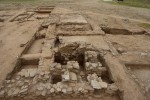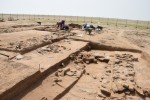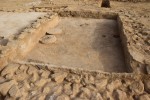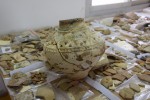 Archaeologists have unearthed the remains of an ancient air conditioning system in a 7th-8th century structure on Failaka, a Kuwaiti island in the Persian Gulf. Researchers from the Slovak Academy of Sciences (SAV) and Kuwait’s National Council for Culture, Arts and Letters excavating the Nestorian Christian village of Al-Qusur discovered the foundations of a stone tower with a complex system of canals inside.
Archaeologists have unearthed the remains of an ancient air conditioning system in a 7th-8th century structure on Failaka, a Kuwaiti island in the Persian Gulf. Researchers from the Slovak Academy of Sciences (SAV) and Kuwait’s National Council for Culture, Arts and Letters excavating the Nestorian Christian village of Al-Qusur discovered the foundations of a stone tower with a complex system of canals inside.
“According to a preliminary analysis, it’s a unique so-called windcatch-tower, utilising an ingenious interior cooling system based on the flow of air, caught by openings in the tower superstructure,” [SAV Archaeological Institute director Matej Ruttkay] claimed.
Windcatchers work by evaporative cooling. Heat converts water to vapour which takes heat with it as it evaporates, just like sweat does for the body. The technology is commonly associated with traditional Persian desert architecture used all over the Middle East today, but there are versions of windcatchers going back to the 19th Dynasty of Pharaonic Egypt (ca. 1300 B.C.). Paintings on Egyptian tomb walls depict roof ventilators that pulled out warm air by suction, but that system is insufficient for the greater heat of the Persian Gulf.
 The Failaka tower enhanced the cooling power of the windcatcher by passing the air over the below-ground water canals into the living spaces of the palace, lowering the temperature of the air dramatically. Modern versions of this system have been clocked cooling the interior of a home to 25°C (77°F) when the external air is 40°C (104°F). It’s a sophisticated approach, impressive for the time and location, and as far as the archaeologists who found it know, is the oldest of its kind ever discovered.
The Failaka tower enhanced the cooling power of the windcatcher by passing the air over the below-ground water canals into the living spaces of the palace, lowering the temperature of the air dramatically. Modern versions of this system have been clocked cooling the interior of a home to 25°C (77°F) when the external air is 40°C (104°F). It’s a sophisticated approach, impressive for the time and location, and as far as the archaeologists who found it know, is the oldest of its kind ever discovered.
Failaka was first settled around 2000 B.C. by Mesopotamians from Ur who ran a trading concern from the island. By 1800 B.C., the Mesopotamians had either left or been escorted off the island by the Dilmun civilization, which at the height of its power encompassed modern-day Bahrain, Kuwait, Qatar and coastal Saudi Arabia. The Dilmunites were maritime merchants who controlled trade in the Persian Gulf. Strategically located at the entrance to Kuwait Bay with an easily defended coastline and native sources of water, Failaka was an important hub of their network. They built extensively on the island, constructing a large temple and nearby palace over the ruins of the old Mesopotamian structures. The construction was imposing. The temple was 60 feet square supported by massive limestone columns made of blocks that had to be imported from the mainland, evidence of how prosperous the Dilmunites were, how significant the Failaka settlement was to them and how big and strong their ships were to make such imports possible.
 In the 7th century B.C., Mesopotamians under Nebuchadnezzar II returned to Failaka and remained there until the end of the Neo-Babylonian Empire after the death of the last king, Nabonidus. Then the Greeks took a turn. Alexander the Great and his successors controlled the island from the 4th to the 1st century B.C.
In the 7th century B.C., Mesopotamians under Nebuchadnezzar II returned to Failaka and remained there until the end of the Neo-Babylonian Empire after the death of the last king, Nabonidus. Then the Greeks took a turn. Alexander the Great and his successors controlled the island from the 4th to the 1st century B.C.
A Nestorian Christian community settled the island starting in the 5th century. The village of Al-Qusur was in the fertile center of Failaka. Today bounded by marshland, when the Nestorians lived there it was fertile agricultural land with tidy irrigation systems and easy access to the sea. Two churches have been found dating to the 5th and 6th centuries, along with a number of modest courtyard homes and farmsteads. The peak of Failaka’s Nestorian era was the 7th and 8th century. The settlement was abandoned in the 9th century.
 The Kuwaiti-Slovak Archaeological Mission has been exploring Failaka since 2004. This season’s aim was to use field excavation, geophysical surveys, aerial photography and 3D modelling to discover the largest structure in Al-Qusur. They were successful beyond their wildest dreams, finding a palatial building dating the 7th-8th century A.D. that was previously unknown. Its architecture of stone masonry foundations topped with mud brick walls is relatively well preserved and its dimensions far eclipse those of the more than 140 settlement structures that have been found at Al-Qusur since it was first excavated in the 1970s. Also it had air conditioning.
The Kuwaiti-Slovak Archaeological Mission has been exploring Failaka since 2004. This season’s aim was to use field excavation, geophysical surveys, aerial photography and 3D modelling to discover the largest structure in Al-Qusur. They were successful beyond their wildest dreams, finding a palatial building dating the 7th-8th century A.D. that was previously unknown. Its architecture of stone masonry foundations topped with mud brick walls is relatively well preserved and its dimensions far eclipse those of the more than 140 settlement structures that have been found at Al-Qusur since it was first excavated in the 1970s. Also it had air conditioning.
Artifacts found in the palace include ceramic and glass vessels, stucco and tile stamps with Christian symbols and Byzantine coins. The latter helped narrow down the date of the find.